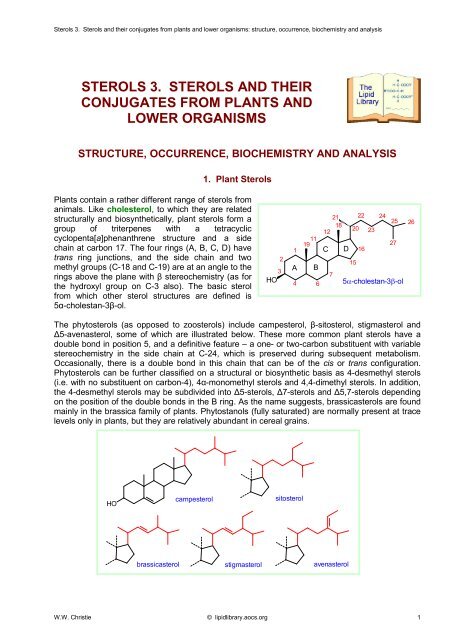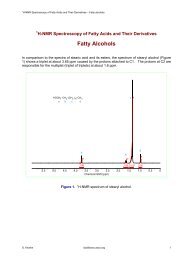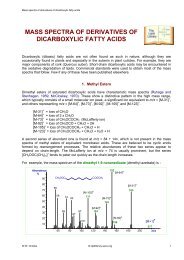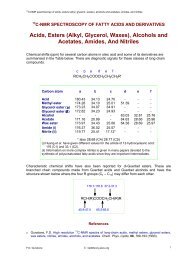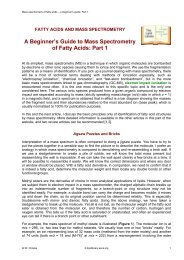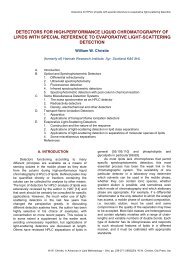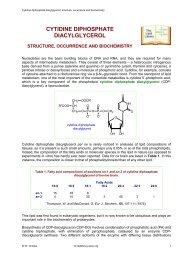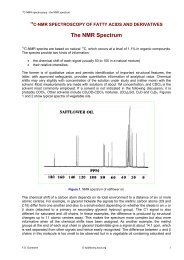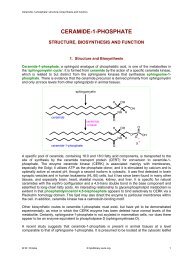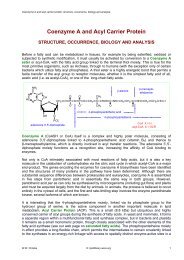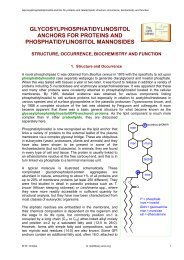STEROLS 3. STEROLS AND THEIR CONJUGATES ... - Lipid Library
STEROLS 3. STEROLS AND THEIR CONJUGATES ... - Lipid Library
STEROLS 3. STEROLS AND THEIR CONJUGATES ... - Lipid Library
You also want an ePaper? Increase the reach of your titles
YUMPU automatically turns print PDFs into web optimized ePapers that Google loves.
Sterols <strong>3.</strong> Sterols and their conjugates from plants and lower organisms: structure, occurrence, biochemistry and analysis<br />
<strong>STEROLS</strong> <strong>3.</strong> <strong>STEROLS</strong> <strong>AND</strong> <strong>THEIR</strong><br />
<strong>CONJUGATES</strong> FROM PLANTS <strong>AND</strong><br />
LOWER ORGANISMS<br />
STRUCTURE, OCCURRENCE, BIOCHEMISTRY <strong>AND</strong> ANALYSIS<br />
1. Plant Sterols<br />
Plants contain a rather different range of sterols from<br />
animals. Like cholesterol, to which they are related<br />
structurally and biosynthetically, plant sterols form a<br />
group of triterpenes with a tetracyclic<br />
cyclopenta[a]phenanthrene structure and a side<br />
chain at carbon 17. The four rings (A, B, C, D) have<br />
trans ring junctions, and the side chain and two<br />
methyl groups (C-18 and C-19) are at an angle to the<br />
rings above the plane with β stereochemistry (as for<br />
the hydroxyl group on C-3 also). The basic sterol<br />
from which other sterol structures are defined is<br />
5α-cholestan-3β-ol.<br />
The phytosterols (as opposed to zoosterols) include campesterol, β-sitosterol, stigmasterol and<br />
∆5-avenasterol, some of which are illustrated below. These more common plant sterols have a<br />
double bond in position 5, and a definitive feature – a one- or two-carbon substituent with variable<br />
stereochemistry in the side chain at C-24, which is preserved during subsequent metabolism.<br />
Occasionally, there is a double bond in this chain that can be of the cis or trans configuration.<br />
Phytosterols can be further classified on a structural or biosynthetic basis as 4-desmethyl sterols<br />
(i.e. with no substituent on carbon-4), 4α-monomethyl sterols and 4,4-dimethyl sterols. In addition,<br />
the 4-desmethyl sterols may be subdivided into ∆5-sterols, ∆7-sterols and ∆5,7-sterols depending<br />
on the position of the double bonds in the B ring. As the name suggests, brassicasterols are found<br />
mainly in the brassica family of plants. Phytostanols (fully saturated) are normally present at trace<br />
levels only in plants, but they are relatively abundant in cereal grains.<br />
a<br />
HO<br />
campesterol<br />
W.W. Christie © lipidlibrary.aocs.org 1<br />
a<br />
2<br />
3<br />
HO<br />
1<br />
sitosterol<br />
11<br />
19<br />
A B<br />
4 6<br />
21<br />
18<br />
12<br />
C D<br />
brassicasterol stigmasterol<br />
avenasterol a<br />
7<br />
20<br />
15<br />
22<br />
16<br />
23<br />
24 25 26<br />
27<br />
5α-cholestan-3β-ol<br />
a
Sterols <strong>3.</strong> Sterols and their conjugates from plants and lower organisms: structure, occurrence, biochemistry and analysis<br />
Many different sterols may be present in photosynthetic organisms, and the amounts and relative<br />
proportions are dependent on the species. Over 200 different sterols have been recorded with 60<br />
in corn alone, for example. As a rough generality, a typical plant sterol mixture would be 70%<br />
sitosterol, 20% stigmasterol and 5% campesterol (or >70% 24-ethyl-sterols and
Sterols <strong>3.</strong> Sterols and their conjugates from plants and lower organisms: structure, occurrence, biochemistry and analysis<br />
‘2C-methyl-D-erythritol 4-phosphate (MEP)’ pathway. In the first step, pyruvate and glyceraldehyde<br />
phosphate are combined to form deoxyxylose phosphate, which is in turn converted to 2C-methyl-<br />
D-erythritol 4-phosphate. The pathway then proceeds via various erythritol intermediates until<br />
isopentenyl pyrophosphate and dimethylallyl pyrophosphate are formed, when sterol biosynthesis<br />
thereafter continues via squalene and cycloartenol. There is evidence that some of the isoprene<br />
units are exchanged between the cytoplasm and plastids.<br />
a<br />
O<br />
COO<br />
O<br />
+ H O<br />
OH<br />
pyruvate glyceraldehyde<br />
phosphate<br />
O O<br />
O P O P<br />
O O<br />
isopentenyl diphosphate<br />
O O<br />
O P O P<br />
O O<br />
dimethylallyl diphosphate<br />
O<br />
P<br />
O<br />
OH<br />
OH<br />
O<br />
OH O<br />
OH<br />
Like cholesterol, plant sterols are amphiphilic and are vital constituents of all membranes, and<br />
especially of the plasma membrane, the mitochondrial outer membrane and the endoplasmic<br />
reticulum. The three-dimensional structure of the plant sterols is such that there are planar<br />
surfaces at both the top and the bottom of the molecules, which permit multiple hydrophobic<br />
interactions between the rigid sterol and the other components of membranes. Indeed, they must<br />
govern the physical properties of membranes to an appreciable extent. It is believed that sitosterol<br />
and 24-methylcholesterol are able to regulate membrane fluidity and permeability in plant<br />
membranes by restricting the mobility of fatty acyl chains in a similar manner to cholesterol in<br />
mammalian cells. They may be involved in how plant membranes adapt to changes in<br />
temperature. Stigmasterol has much less effect on lipid ordering and no effect on the permeability<br />
of membranes. In the plasma membrane, plant sterols associate with the glycosphingolipids such<br />
as glucosylceramide in raft-like subdomains, analogous to those in animal cells.<br />
Plant sterols can modulate the activity of membrane-bound enzymes. Thus, stigmasterol and<br />
cholesterol regulate the activity of the Na + /K + -ATPase in plant cells, probably in a manner<br />
analogous to that of cholesterol in animal cells. Stigmasterol may be required specifically for cell<br />
differentiation and proliferation. Certain sterols, such as campesterol in Arabidopsis thaliana, in<br />
minute amounts are precursors of polyhydroxy steroids that act as growth hormones and are<br />
collectively named brassinosteroids, which have crucial importance for growth and development.<br />
Withanolides are complex oxysterols, which are believed to be defence compounds against insect<br />
herbivores. Cholesterol is a precursor for the biosynthesis of some steroidal saponins and<br />
alkaloids, as well as of other steroids including the ecdysteroids (insect moulting hormones).<br />
Substantial amounts of phytosterols are available as by-products of the refining of vegetable oils<br />
and of tall oil from the wood pulp industry. There is increasing interest in such commercial sources<br />
of plant sterols to be added as “nutraceuticals” to margarines and other foods, as it appears that<br />
they can inhibit the uptake of cholesterol from the diet and thereby reduce the levels of this in the<br />
W.W. Christie © lipidlibrary.aocs.org 3<br />
OH<br />
OH<br />
O<br />
P<br />
O<br />
OH<br />
OH<br />
OH<br />
OH<br />
deoxyxylose phosphate 2-C-methyl-D-erythritol<br />
4-phosphate<br />
O O<br />
O P O P<br />
O O<br />
2-methylbutane-1,4-diol<br />
diphosphate<br />
OH<br />
O<br />
O<br />
P<br />
O<br />
various erythritol<br />
phosphate<br />
intermediates<br />
OH<br />
a
Sterols <strong>3.</strong> Sterols and their conjugates from plants and lower organisms: structure, occurrence, biochemistry and analysis<br />
plasma low-density lipoproteins. Hydrogenated phytosterols or “stanols” are also used for this<br />
purpose. In addition, dietary supplements of plant sterols have been reported to have anti-cancer<br />
effects. The actual absorption of dietary plant sterols and stanols in humans is low (0.02-<strong>3.</strong>5%)<br />
compared to cholesterol (35-70%). In some rare cases, increased levels of plant sterols in plasma<br />
serve as markers for an inherited lipid storage disease (phytosterolemia). There is evidence that<br />
while plant sterols can substitute for cholesterol in maintaining membrane function in mammalian<br />
cells, they can exert harmful effects by disrupting cholesterol homeostasis.<br />
Phytosterols can be subjected to autoxidation with formation of oxysterols in a similar manner to<br />
that of cholesterol in animals, resulting in ring products such as hydroxy-, keto-, epoxy- and triolderivatives.<br />
In addition, enzymic reactions can oxidize the side chain. These oxy-phytosterols can<br />
enter the food chain and, although they are not efficiently absorbed, they have been detected in<br />
human plasma and have the potential to exert a variety of biological effects. They are discussed in<br />
relation to their formation in frying oils elsewhere on this site.<br />
2. Sterols in Yeasts and Fungi<br />
Yeasts and fungi, together with microalgae and<br />
protozoa, can contain an enormous range of different<br />
sterols. Ergosterol ((22E)-ergosta-5,7,22-trien-3β-ol) is<br />
the main sterol in fungi and yeasts, and is accompanied<br />
by other sterols not normally abundant in higher plants<br />
including zymosterol (5α-cholesta-8,24-dien-3β-ol). Like<br />
cholesterol and in contrast to the plant sterols, it is<br />
synthesised via lanosterol as the key intermediate.<br />
Some antifungal drugs are targeted against ergosterol<br />
biosynthesis. Under some conditions, especially those<br />
HO<br />
ergosterol<br />
that retard growth, a high proportion of the sterols in yeasts can be in esterified form.<br />
Many mutants defective in ergosterol biosynthesis have been isolated, and these have yielded a<br />
great deal of information on the features of the sterol molecule required for its structural role in<br />
membranes of yeast and fungi. Ergosterol stabilizes the liquid-ordered phase in the same manner<br />
as cholesterol, and also forms rafts with sphingolipids, whereas lanosterol does not. It is also<br />
evident that ergosterol has a multiplicity of functions in the regulation of yeast growth.<br />
Ergosterol esters are synthesised in yeast by enzymes (ARE1 and ARE2) related to ACAT1 and<br />
ACAT2 that perform this function in animals.<br />
Protozoans also synthesise many different sterols. For example, some species of Acanthamoeba<br />
and Naegleria produce both lanosterol and cycloartenol, but only latter is used for synthesis of<br />
other sterols, especially ergosterol. In some other protozoan species, sterol biosynthesis occurs via<br />
lanosterol.<br />
<strong>3.</strong> Bacterial Sterols<br />
Hopanoids take the place of sterols in many species of bacteria, but it has long been recognised<br />
that some bacteria take up cholesterol and other sterols from host animals for use as membrane<br />
constituents. Indeed, an external source of sterols is required for growth in species of Mycoplasma.<br />
In addition, there have been a number of reports of biosynthesis of sterols by various bacterial<br />
species, although a high proportion of these appear now to have been discounted because of<br />
fungal contamination. In particular, the possibility of sterol biosynthesis in cyanobacteria has been<br />
W.W. Christie © lipidlibrary.aocs.org 4
Sterols <strong>3.</strong> Sterols and their conjugates from plants and lower organisms: structure, occurrence, biochemistry and analysis<br />
controversial, and molecular biology studies have yet to detect the presence of the required<br />
enzyme squalene epoxide cyclase.<br />
That said, there is good evidence that a few species of prokaryotes at least have the capacity to<br />
synthesise sterols de novo. Among the eubacteria certain methylotrophs (Methylobacterium and<br />
Methylosphaera species) produce mono- and dimethyl sterols, including lanosterol. Similarly, some<br />
soil bacteria produce 4-desmethylsterols. It has now been established from gene sequence studies<br />
that certain bacteria contain enzymes of the sterol biosynthesis pathway, but as these have no<br />
obvious evolutionary link it seems probable that they were acquired via lateral transfer from<br />
eukaryotes.<br />
4. Sterol Esters<br />
Sterol esters are present in plant tissues, but as minor components relative to the free sterols<br />
other than in waxes. Usually the sterol components of sterol esters are similar to the free sterols,<br />
although there may be relatively less of stigmasterol. The fatty acid components tend to resemble<br />
those of the other plant tissue lipids, but there can be significant differences on occasion. Sterol<br />
esters are presumed to serve as inert storage forms of sterols, as they are often enriched in the<br />
intermediates of sterol biosynthesis and can accumulate in lipid droplets within the cells. However,<br />
they have been found in membranes, especially in microsomes and mitochondrial preparations<br />
although their function here is uncertain. They may also have a role in transport within cells and<br />
between tissues, as they have been found in the form of soluble lipoprotein complexes.<br />
Biosynthesis of sterol esters in Arabidopsis thaliana is known to occur in the endoplasmic reticulum<br />
and involves transfer of a fatty acyl group to the sterol from position sn-2 of<br />
phosphatidylethanolamine. However, other enzymes may exist but have yet to be characterized. In<br />
yeasts, two sterol ester synthases have been identified that utilize CoA esters of fatty acids as<br />
substrate. Little appears to be known of the catabolism of sterol esters in plants, but specific sterol<br />
ester hydrolases have been characterized from yeasts.<br />
Certain distinctive phytosterol<br />
esters occur in the aleurone cells<br />
of cereal grains, including transhydroxycinnamate,<br />
ferulate (4hydroxy-3-methoxy<br />
cinnamate) and<br />
p-coumarate esters. Similarly, rice<br />
bran oil is a rich source of esters of<br />
ferulic acid and a mixture of sterols<br />
O<br />
and triterpenols, termed<br />
O<br />
‘γ-orizanol’, and an example of one<br />
of these compounds is illustrated.<br />
This is sold as a health food<br />
supplement, because of claimed<br />
HO<br />
CH3O campesteryl<br />
ferulate<br />
beneficial effects, including cholesterol-lowering and antioxidant activities. It is also reputed to<br />
enhance muscle growth and sports performance. However, none of these effects have been<br />
confirmed by rigorous clinical testing.<br />
5. Sterol Glycosides<br />
Leaf and other tissues in plants contain a range of sterol glycosides and acyl sterol glycosides,<br />
in which the hydroxyl group at C3 on the sterol is linked to the sugar by a glycosidic bond. Typical<br />
examples (glucosides of β-sitosterol) are illustrated below. Most of the common plant sterols occur<br />
W.W. Christie © lipidlibrary.aocs.org 5
Sterols <strong>3.</strong> Sterols and their conjugates from plants and lower organisms: structure, occurrence, biochemistry and analysis<br />
in this form, but ∆5 sterols are preferred (∆7 in some genera). The carbohydrate moieties (glucose,<br />
xylose, arabinose) can vary also with the plant species, and they can sometimes be quite complex<br />
with up to five hexose units linked in a linear fashion. Similarly, the nature of the fatty acid<br />
component in the acyl sterol glycosides can vary as well as the hydroxyl group to which they are<br />
linked, although it is usually position 6. In potato tubers, for example, the 6'-palmitoyl-β-D-glucoside<br />
of β-sitosterol is the major species, while the corresponding linoleate derivative predominates in<br />
soybeans. Usually, the acyl sterol glycosides are present at concentrations that are two to ten fold<br />
greater than those of the non-acylated forms. They are known to be located in the plasma<br />
membrane, tonoplasts and endoplasmic reticulum. Plant, animal, fungal and most bacterial sterol<br />
glycosides have a β-glycosidic linkage, but in a few bacterial species there is an α-linkage.<br />
HO<br />
CH2OH<br />
O<br />
OH<br />
OH<br />
O<br />
sterol glucoside<br />
CH2OOCR O<br />
acyl sterol glucoside<br />
Sterol glycosides have only rarely been reported from organisms other than plants, although<br />
cholesteryl glucoside has been found in a few animal tissues and some bacteria, such as the<br />
gram-negative bacterium Helicobacter pylori and Borrelia burgdorferi, the causative agent of Lyme<br />
disease (see our web page on cholesterol oxides and related compounds). Many fungal species<br />
and slime moulds contain steryl glycosides (ergosteryl β-monoglucopyranosides in the former), but<br />
they are present at very low levels only in the widely studied yeast Saccharomyces cerevisiae<br />
In addition, a number of species of monocotyledons contain complex steroidal saponins, which<br />
consist of an aglycone based on a triterpenoid, furostanol or spirostanol skeleton and an<br />
oligosaccharide chain of two to five hexose or pentose moieties attached to the 3-hydroxyl group of<br />
the sterol.<br />
Biosynthesis involves reaction of free sterols with uridine diphosphoglucose (UDP-glucose) in the<br />
presence of a UDP-glucose:sterol glucosyltransferase on the cytosolic side of the plasma<br />
membrane. The acyl donor for acyl sterol glycoside synthesis is not acyl-coenzyme A but<br />
glycerolipids.<br />
Little is known of the functions of sterol glycosides and acyl sterol glycosides, but the latter may be<br />
involved in the adaptation of plant membranes to low temperatures. Sitosterol-β-D-glucoside in the<br />
plasma membrane is the primer molecule for cellulose synthesis in plants, as in cotton (Gossypium<br />
arboreum) fiber, and it is required for the initiation of glucan polymerization. The sterol is eventually<br />
removed from the polymer by a specific cellulase enzyme. One route to the biosynthesis of<br />
glucosylceramides in plants involves transfer of the glucose moiety of sterol glycosides to<br />
ceramide. Sterol glycosides also appear to be essential for the pathogenicity of certain fungi and<br />
bacteria.<br />
In the human diet, sterol glycosides have potential benefits in that like free sterols they inhibit the<br />
absorption of cholesterol from the gut, thus decreasing the risk of cardiovascular diseases.<br />
W.W. Christie © lipidlibrary.aocs.org 6<br />
HO<br />
OH<br />
OH<br />
O
Sterols <strong>3.</strong> Sterols and their conjugates from plants and lower organisms: structure, occurrence, biochemistry and analysis<br />
6. Analysis<br />
In the analysis of animal and plant sterols, a sterol fraction is first isolated from lipid extracts by<br />
thin-layer or column chromatography, following hydrolysis if necessary. Individual components can<br />
then be determined by gas chromatography in the presence of an internal standard (e.g.<br />
epicoprostanol or betulin), often after conversion to trimethylsilyl ether derivatives to give sharper<br />
peaks. Mass spectrometry may be required for identification of individual components. Analysis of<br />
the minor oxysterols that may be found in plasma or foods is a rather specialized task, because<br />
they tend to be present at rather low levels and there is a danger of further oxidation or side<br />
reactions during the analytical process. Rigorous attention to detail is necessary for meaningful<br />
results.<br />
Sterol esters are trans-methylated for GC analysis of the fatty acid components, although the<br />
reaction may again be much slower than with glycerolipids. Intact sterol esters are best analysed<br />
by reversed-phase HPLC. Analysis of sterol glycosides is a more specialized endeavour that can<br />
be concerned as much with with carbohydrate as with lipid chemistry.<br />
Suggested Reading<br />
o Christie, W.W. and Han, X. <strong>Lipid</strong> Analysis - Isolation, Separation, Identification and <strong>Lipid</strong>omic Analysis<br />
(4 th edition), 446 pages (Oily Press, Bridgwater, U.K.) (2010).<br />
o Dyas, L. and Goad, L.J. Steryl fatty acyl esters in plants. Phytochemistry, 34, 17-29 (1993).<br />
o Fernandes, P. and Cabral, J.M.S. Phytosterols: applications and recovery methods. Bioresource<br />
Technology, 98, 2335-2350 (2007).<br />
o Garcia-Llatas, G. and Rodriguez-Estrada, M.T. Current and new insights on phytosterol oxides in plant<br />
sterol-enriched food. Chem. Phys. <strong>Lipid</strong>s, 164, 607-624 (2011).<br />
o Grille, S., Zaslawski, A., Thiele, S., Plat, J. and Warnecke, D. The functions of steryl glycosides come to<br />
those who wait: Recent advances in plants, fungi, bacteria and animals. Prog. <strong>Lipid</strong> Res., 49, 262-288<br />
(2010).<br />
o Hartmann, M.-A. Sterol metabolism and function in higher plants. In: <strong>Lipid</strong> Metabolism and Membrane<br />
Biogenesis. pp. 183-211 (ed. G. Daum, Springer-Verlag, Heidelberg) (2004).<br />
o Heinz, E. Plant glycolipids: structure, isolation and analysis. In: Advances in <strong>Lipid</strong> Methodology – Three,<br />
pp. 211-332 (ed. W.W. Christie, Oily Press, Dundee) (1996).<br />
o Hunter, W.N. The non-mevalonate pathway of isoprenoid precursor biosynthesis. J. Biol. Chem., 282,<br />
21573-21577 (2007).<br />
o Moreau, R.A., Whitaker, B.D. and Hicks, K.B. Phyosterols, phytostanols, and their conjugates in foods:<br />
structural diversity, quantitative analysis, and health-promoting uses. Progr. <strong>Lipid</strong> Res., 41, 457-500<br />
(2002).<br />
o Nes, W.D. Biosynthesis of cholesterol and other sterols. Chem. Rev., 111, 6423–6451 (2011).<br />
o Nyström, L., Schär, A. and Lampi, A.-M. Steryl glycosides and acylated steryl glycosides in plant foods<br />
reflect unique sterol patterns. Eur. J. <strong>Lipid</strong> Sci. Technol., 114, 656–669 (2012).<br />
o Ostlund, R.E. Phytosterols, cholesterol absorption and healthy diets. <strong>Lipid</strong>s, 42, 41-45 (2007).<br />
o Rohmer, M. From molecular fossils of bacterial hopanoids to the formation of isoprene units: discovery<br />
and elucidation of the methylerythritol phosphate pathway. <strong>Lipid</strong>s, 43, 1095-1107 (2008).<br />
o Schaller, H. The role of sterols in plant growth and development. Prog. <strong>Lipid</strong> Res., 42, 163-175 (2003).<br />
o Volkman, J.K. Sterols in microorganisms. Appl. Microbiol. Biotechn., 60, 495-506 (2003).<br />
o Volkman, J.K. Sterols and other triterpenoids: source specificity and evolution of biosynthetic pathways.<br />
Org. Geochem., 36, 139-159 (2005).<br />
W.W. Christie © lipidlibrary.aocs.org 7
Sterols <strong>3.</strong> Sterols and their conjugates from plants and lower organisms: structure, occurrence, biochemistry and analysis<br />
William W. Christie<br />
James Hutton Institute (and Mylnefield <strong>Lipid</strong> Analysis), Invergowrie, Dundee (DD2<br />
5DA), Scotland<br />
Last updated: June 28 th , 2012<br />
W.W. Christie © lipidlibrary.aocs.org 8


